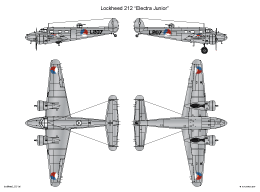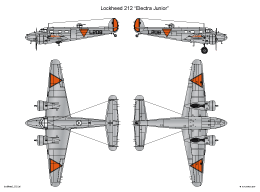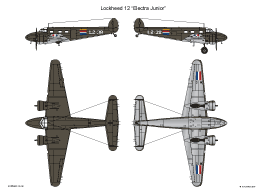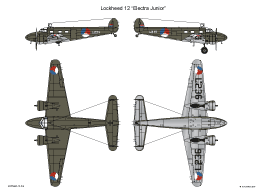Nederlandse Modelbouw en Luchtvaartsite
Dutch Modelling and Aviation
Lockheed L-12a en 212
History
About a year after the Lockheed Electra was released in 1910, Lockheed began to develop a smaller version, the Lockheed Model 12 Electra Junior, which was fitted with the same engines.
The first flight was in June 1936.
U.S. Navy received seven aircraft and the USAAC bought a dozen examples under the designation under the Lockheed C-40 and C-40A.
Several businessmen inside and outside the U.S. bought the Lockheed 12A.
Ninety examples of the Lockheed 12A were eventually built.
In September 1937, the Lockheed Model 12B and 12-3 in 1941, both with stronger engines, were released.
A total of 130 Electra Juniors were built in five different versions.
Just before the war two aircraft were used for photo reconnaissance by Sydney Cotton, who had converted a number of aircraft and thus performed photo flights for the Intelligence Services at great height over Germany and Italy.
Versions
- Model 12A:
- 70 examples of the original version equipped with two Pratt & Whitney R-985 Wasp Junior SB radial engines rated 450 hp each.
- C-40: Three examples for USAAC for five passengers; From January 1943 and on designated as UC-40.
- C-40A: Ten examples foor USAAC for transport of passengers and freight plus one converted C-40B; From January 1943 and on designated as UC-40A.
- C-40B: One example for testing fixed undercarriage; later converted to C-40A
- C-40D: Eleven impressed civil Model 12As. From January 1943 and on designated as UC-40D.
- JO-1: One example built for US Navy for five passengers.
- JO-2: Five examples built for US Navy and Marine Corps for six passengers.
- XJO-3: One examples with fixed undercarriage built for US Navy for testing landings on aircraft carriers.
- R3O-2: One Model 12A impressed by the US Navy.
- Model 12B:
- Two examples for the Argentine army equipped with two Wright R-975-E3 Whirlwind radial engines rated 440 hp each.
- Model 12-25:
- Two examples with two Pratt & Whitney R-985 Wasp Junior SB3 radial engines.
- Model 212:
- trainer with bomb racks, dorsal turret. Sixteen examples built plus one prototype, for NEIAF.
- Model 12-26:
- transport version of the Model 212; twenty examples built for NEIAF.
| Dimensions: | |||
| Length: | 11,07 m | Wingspan: | 15,09 m |
| Height: | 2,97 m | Wing area: | 32,7 m2 |
| Weights: | |||
| Empty weight: | 2615 kg | Max. start weight: | 3924 kg |
| Performances: | |||
| Max. speed: | - km/hr | Climbing speed: | 427 m/min |
| Cruising speed: | 362 km/hr | ||
| Range: | 1287 km | Service ceiling: | 6980 m |
| Miscellaneous: | |||
| Engine type: | Two Pratt & Whitney R-985 AN-2 Wasp Jr rated 450 hp each | ||
| Crew: | - | ||
| Armament: | None | ||
| Dimensions: | |||
| Length: | 11,07 m | Wingspan: | 15,09 m |
| Height: | 2,97 m | Wing area: | 32,7 m2 |
| Weights: | |||
| Empty weight: | 2703 kg | Max. start weight: | 3883 kg |
| Performances: | |||
| Max. speed: | - km/hr | Climbing speed: | 427 m/min |
| Cruising speed: | 362 km/hr | ||
| Range: | 1287 km | Service ceiling: | 6980 m |
| Miscellaneous: | |||
| Engine type: | Two Pratt & Whitney R-985 AN-2 Wasp Jr rated 450 hp each | ||
| Crew: | - | ||
| Armament: | Two fixed forward firing machine guns in the nose; on moveable machine gun in a turret | ||
In service with RNlAF, NEIAF and RAF
In service with NEIAF.
Late thirties the NEIAF expanded and therefore there was need for a multi-engine training aircraft.
This aircraft must be equipped dual controls, retractable landing gear, allowing an a rotating machine gun turret for training of air gunners and equipment shedding light bombs for training of bombardiers.
It could therefore also limited operational deployment.
Lockheed began in 1938 with the development of a military version of the Lockheed 12, the Lockheed Model 212.
The NEIAF was the first customer and ordered on September 27, 1938 12 Lockheed 212-26 trainers.
The first NEI Lockheed 212, c/n 212-01 L201 and registration made on March 7, 1939 the first flight.
The first five machines arrived in June 1939, at Surabaya, where they were assembled.
In October 1939 another four were ordered, which were delivered in April 1940, these were designated Lockheed 212A-13.
After the Netherlands was occupied, attempts were done to acquire more units, however, due to the lack of engines and the American Purchasing committee, this process run considerably slower than the previous orders.
On September 24, 1940 a request was applied by the NPC (Netherlands Purchasing Committee)for 10 Lockheed 12's. This request was approved in October 1940, but without the necessary R-985 engines, which had to obtained from the British.
The British refused to release the engines, so that request was withdrawn in April 1941. The serials L-217 to L-226 were already reserved for these aircraft.
On November 27, 1940 a request followed for ten Lockheed 212s, which was approved, this time including the engines.
This (third) order for the Lockheed 212s was soon converted into an order for Lockheed 12s, because the Lockheed 212 was no longer in production.
Another request on February 14, 1941 for another ten Lockheed 12s was approved on 9 April that year, so on June 6, 1941 this order was placed at Lockheed.
MLD, who was planning to buy the Douglas Boston, also needed a multi-engine trainer, and demanded in January 1941 for seven Lockheed 212s and Lockheed received in February a request for another seventeen pieces.
The Wright engines, intended for the Fokker T. VIIIw, were still available and delivered in England.
Because the Lockheed 212 was discontinued, the request was converted into Lockheed 12.
Both were rejected because Lockheed had been overloaded with orders, so it was recommended to purchase 24 Beech AT-11 Kansans.
Mid August 1940, the registration system of the ML-KNIL was changed. It now consisted of one or two letters indicating the manufacturer, than one digit, representing the class of the aircraft, e.g. 2 was a transitional aircraft, followed by two or more numbers indicating the sequence number.
The first three Lockheed 12s were completed in October 1941, three in December 1941 and four in January 1942. Meanwhile, the war in Dutch East Indies was in full swing.
The first Lockheed 12 was sent to England, for Prince Bernhard, where it arrived in August 1942.
The plane received RAF serial number NF753 and PB-2.
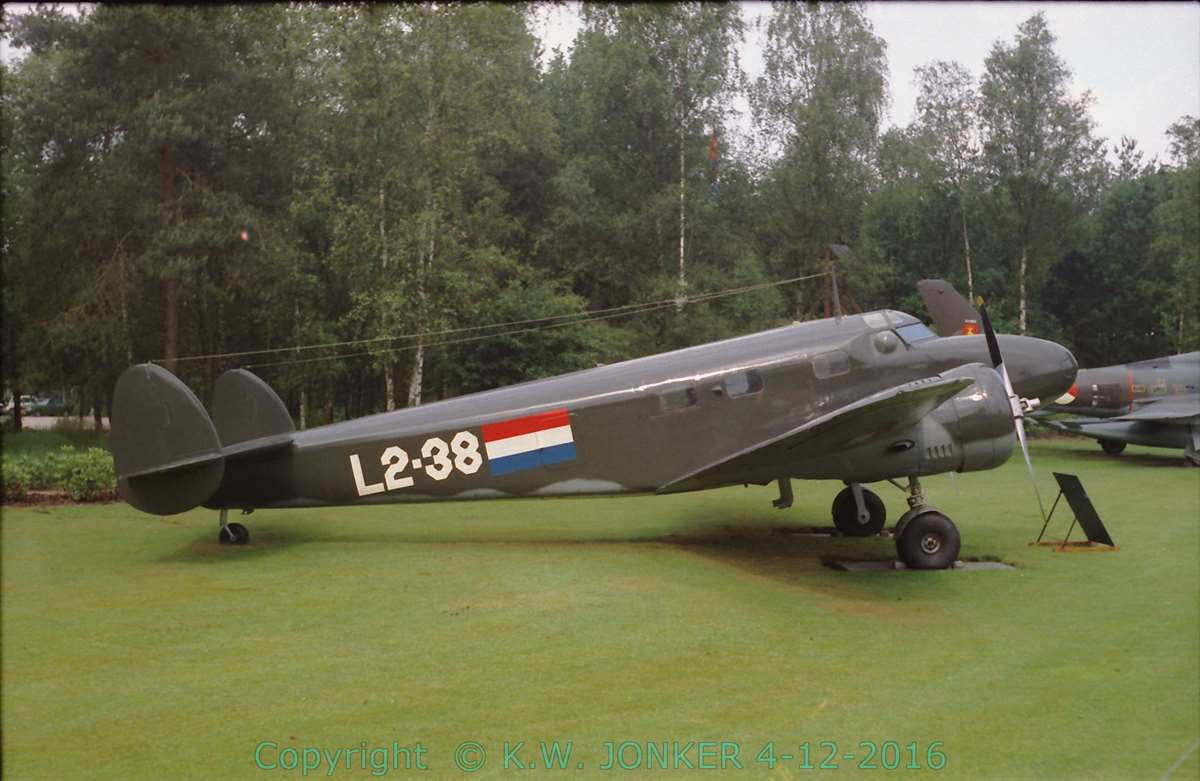
Lockheed 12, L2-38, photographed in 1985 at the Militaire Luchtvaart Museum at Soesterberg.
War
8 December 1941, war with Japan broke out and maritime reconnaissance unit with nine Lockheed 212s was established, the fourth section of IV aircraft group, 4-VLG-IV.
The armament of these devices was very useful. It was also possible to mount a machine gun in the nose, but for unknown reasons it never worked out well.
The range of the Lockheed 212 with bomb-load and the dorsal turret in operational position, was about 1200 km, which is rather limited for a patrol plane. This problem was solved by a stop-over at various airfields along the coast.
During such a patrol flight was on January 1, 1942 Lockheed L-215 lost.
At he end of January and early February it was commissioned to assessed to continue the training programs from Australia. The planes had to be evacuated.
It was possible to do this with the aircraft tender USS Langley, but this ship was sunk near Cilacap by the Japanese. Also, one could add additional fuel tanks in the aircraft or to take fuel.
For unknown reasons, this was not done.
It was ordered to destroy the aircraft "without smoke and fire", usually this was accomplished by retracting the landing gear and destroy fuel tanks with axes.
The six Lockheed of the Flying School were destroyed, that same happened with the two Lockheeds at the Depot VliegtuigAfdeling (Depot aircraft Division).
These were probably the two Lockheeds 12, which had just arrived from America.
Certainly one Lockheed 12 was used by the Japanese.
The ensign Pelders managed to flee with the L201 to Ceylon after repairs and this aircraft was sent to Karachi.
Among the Lockheeds which were directed to Australia, were L2-34 and L2-35. These were initially used by the staff of the ML, which had been evacuated to Australia.
The L2-L2-31 and 33 were shortly after arrival on March 22, 1944, taken over by the Americans.
Not long after, most of ML material which arrived in Australia was handed over to the U.S. Only Lockheed L2-34 remained in Dutch service.
The two Lockheed 12 that were sent to Ceylon, were flown to Karachi, where Bangalore Detachment was assigned to pick up the North American B-25s, which currently has five examples had arrived.
Period at the end of the war
The remaining eleven aircraft, available in the U.S., were flown to the Royal Netherlands Military Flying School in May 1942. Initially these had the U.S. insignia applied.
The devices were used for multi-engine training, navigation training and training of radio officers and also used for light transport flights.
In March 1943, after the second group students was certified, there was less employability for the Lockheeds.
As the ML in Australia needed such aircraft, a total of seven Lockheeds was sent to Australia. The L2-40 was the first on March 19, 1943, the second, L-41 followed on May 20, the last in November 1943.
Post-war
In Australia two Transport sections were formed during 1943.
One, NEITSB, NEI Transport Section Brisbane, consisted mainly of KLM and KNILM crews, and flew mainly for the USAAF.
The other, NEITSM, NEI Transportation Section Melbourne, was intended for use by the ML.
This had a variety of aircraft types, varying from old B-25s, Lockheed Lodestars and Lockheed 12, L2-35 and, after some time, the Lockheeds from Jackson.
In 1944 TSM received squadron status and was known as no. 1 NEI Transport Squadron.
The Lockheeds were re-registered in 1944 and their new serials were L2-100 till L2-107.
L2-100 (ex L2-35) was permanently loaned to 120 Squadron at Merauke. Also some of the other devices were loaned to 120 and 18 squadron for shorter or longer period.
For the Australian air traffic the Lockheeds were also assigned Australian civil registrations.
In mid August 1945 the thus far independent squadron was transformed to no 19 Squadron RAAF NEI. Mainly for political reasons.
The Australian, very left-wing unions were strongly opposed to the return of Dutch power in Indonesia and caused many troubles.
In February 1946 the five Lockheed went over to the squadron of the Air Base Detachment Tjililitan in Java. Lockheed L2-106 was written off at that time.
Some were stored. In March 1948 multi-engine training started to progress, so five went to the Flying School.
A sixth aircraft which was assigned to the PVA since July 1947 was added in May 1948.
The seventh Lockheed was in us for staff aircraft of the Air Command Java since May 1947.
In March 1950 the remaining Lockheeds were handed over to Indonesia.
In service with the RAF.
The two Lockheeds 12, which were sent to Ceylon were handed over to the RAF, together with de Mitchells on June 12, 1942.
Lockheed L2-30 received RAF serial LV761 and was withdrawn from use on August 31, 1944. Is is possible though, that this aircraft has been used by the Metropolitan Communications Flight. This would have been for a very short period.
The L201, which was flown to Karachi by ensign Pelders, received registration LV762 and was written off after a crash on July 18, 1944.
L2-32, was registered LV760 and was written off after a belly landing at Kanchrapara on March 3, 1945. The serial was applied on the aircraft as LV700.
Since the training at the Flying School at Jackson in October 1943 was completed, the remaining four were on loan to KLM for the West Indian company in Curacao. Eventually one was used for charter flights and training, with civilian registration PJ -AKC, the others were stored.
Beginning 1945, these aircraft were sent to England. On July 7, 1944 an air service was established.
This was known as Dutch Communications Flight, was part of the Allied Flight of the Metropolitan Communications Squadron at RAF Hendon airfield.
The first Dutch aircraft were already added in March 1944 to the Allied Flight, namely a Proctor, a Hudson, four Dominions, an Auster III and the Lockheed 12 PB-2.
The first of four Lockheed was added in June, the last just in January 1946.
In service with RNlAF.
At the end of 1945 the DCF moved from Hendon to airbase Valkenburg, where on June 17, 1946 the Dutch Transport Aircraft Division, TransVA, was formed containing the material of the DCF plus a number of Austers.
The Lockheed had at least on paper fictitious RAF records, AX236, BX238, CX245, DX246 and EX753 assigned, but these are not always applied.
For example, the L2-45 / CX245 brought in June 1945 Princess Juliana to Deelen, and then still had the original L2-serial applied.
The Lockheeds were re-registered with T-registrations and were mainly used for various tasks in addition to transport also as target tugs for aircraft artillery. The T2 and T-3 had a cabin window replaced by a blister.
The remaining aircraft, the T3 and T-5 had already crashed, were sold to Sweden in April 1953. Lockheed L2-38 is nowadays on display for many in the Military Aviation Museum at Soesterberg.

Museum aircraft Lockheed 12A in front of a hangaar at airbase Soesterberg.
[Enclosed photo from BeeldBank NIMH. Click on photo for ordering information]
[Enclosed photo from BeeldBank NIMH. Click on photo for ordering information]

Arrival of General M.P.J.F. Koenig, commander of the French occupation zone in Germany, for a visit to the Netherlands in April 1948. The aircraft a Dutch Lockheed 12 has the name "Utrecht".
[Enclosed photo from BeeldBank NIMH. Click on photo for ordering information]
[Enclosed photo from BeeldBank NIMH. Click on photo for ordering information]

Three Lockheed 12A's at airbase Valkenburg.
[Enclosed photo from BeeldBank NIMH. Click on photo for ordering information]
[Enclosed photo from BeeldBank NIMH. Click on photo for ordering information]
Serial overview RNlAF; NIEAF and RAF.
Serial overview Lockheed 212 NEIAF.
| Serial
Serial
| Constr. nr.
Constr. nr.
| Date in service
Date in service
| Date out of service
Date out of service
| Notes
Notes
|
|---|---|---|---|---|
|
Lockheed Model 212A-26 |
||||
| L-201 | 212-001 | 09-12-1941 | 12-06-1942 | Between March 3, 1939 and April 10, 1939 tested by NLL at Burbank May 6, 1939 shipped from Los Angeles March 9,1942 escaped to Ceylon June 12, 1942 handed over to RAF as LV762 July 18, 1944 crashed near New Delhi. |
| L-202 | 212-002 | May 6, 1939 shipped from Los Angeles | ||
| L-203 | 212-003 | May 6, 1939 shipped from Los Angeles | ||
| L-204 | 212-004 | May 6, 1939 shipped from Los Angeles | ||
| L-205 | 212-005 | May 6, 1939 shipped from Los Angeles | ||
| L-206 | 212-006 | May 12, 1939 shipped from Los Angeles | ||
| L-207 | 212-007 | May 12, 1939 shipped from Los Angeles | ||
| L-208 | 212-008 | May 12, 1939 shipped from Los Angeles | ||
| L-209 | 212-009 | May 29, 1939 shipped from Los Angeles | ||
| L-210 | 212-010 | May 29, 1939 shipped from Los Angeles | ||
| L-211 | 212-011 | June 5, 1939 shipped from Los Angeles | ||
| L-212 | 212-012 | June 5, 1939 shipped from Los Angeles | ||
| Lockheed Model 212-14 | ||||
| L-213 | 212-014 | February 2, 1940 shipped from Los Angeles | ||
| L-214 | 212-015 | February 7, 1940 shipped from Los Angeles | ||
| L-215 | 212-016 | 01-01-1942 | February 15, 1940 shipped from Los Angeles Missed near Banka. |
|
| L-215 | 212-017 | February 15, 1940 shipped from Los Angeles | ||
Serial overview Lockheed 12a NEIAF
| Serial
Serial
| Constr. nr.
Constr. nr.
| Date in service
Date in service
| Date out of service
Date out of service
| Notes
Notes
|
|---|---|---|---|---|
| Registrations L2-17 till L2-26 were reserved, but the order was cancelled because no engines were available | ||||
| L2-27 | 1295 | 24-10-1941 | 17-01-1945 | Shipped to England for hrh Prince Bernhard. 06-08-1942 arrival at Liverpool 21-08-1942 RAF serial NF735 to NQ 24 squadron, as PB-2 30-05-1944 to1316 Flight. 17-01-1945 handed over to Dutch Government as "EX735'( fake RAF serial) |
| L2-28 | 1296 | 24-10-1942 | 08-03-1942 | Captured by the Japanese. Tested in Japan |
| L2-29 | 1297 | 29-10-1941 | 08-03-1942 | Captured by the Japanese. Tested in Japan |
| L2-30 | 1298 | 29-12-1941 | 12-06-1942 | Shipped to Ceylon March 11, 1942 June 12, 1942 handed over to RAF, LV761 |
| L2-31 | 1299 | 29-12-1941 | 02-05-1942? | Assigned to 21 squadron 374 TCG USAF? Lost between 26-04-1942 and 02-05-1942? [possibly L2-33?] |
| L2-32 | 1300 | 29-12-1941 | 12-06-1942 | Shipped to Ceylon March 11, 1942
June 12, 1942 handed over to RAF, LV760 |
| L2-33 | 1301 | 07-01-1941 | 02-05-1942? | Assigned to 21 squadron 374 TCG USAF? Lost between 26-04-1942 and 02-05-1942? [possibly L2-31?] |
| L2-34 | 1302 | 31-02-1942 | Arrived in Australia and in April 1942 to HQ-ML at Laverton may 3, 1942 handed over to USAAF, 3rd Bomb group. later sold as VH-ASG, laer 9M-ANK; crashed on October 26, 1966 near Buki Tesi. |
|
| L2-35 | 1303 | 31-01-1942 | 1950 | Arrived in Australia and in April 1942 to HQ-ML at Laverton February 1944 to NEI TSM, serial L2-100, call sign VH-RDO; In 1948 re-registered as T-310 1950 handed over to AURIS |
| L2-36 | 1304 | 31-01-1942 | 24-05-1952 | May 30, 1942 to RNMFS at Jackson To KLM West Indian company at Curacao as PJ-AKC 1945 to no 1316 Flight as AX 236 (fake RAF serial) September 1946 to 1 TransVa as T-1. Withdrawn from use. Sold as SE-BXP, later OY-ADP September 1965 scrapped at Kastrup, Denmark. |
|
Lockheed Model 12A-26 |
||||
| L2-37 | 1305 | 06-02-1942 | 1950 | May 30, 1942 to RNMFS at Jackson August 1943 to no 1 NEITS Australia May 1944 serial L2-101, call sign VH-RDP 1948 re-registered as T-301 To AURIS |
| L2-38 | 1307 | 06-02-1942 | 03-10-1951 | May 30, 1942 to RNMFS at Jackson February 1944 To KLM West Indian company at Curacao as PJ-AKD (not used) 1945 to 1316 Flight as NX238 9fake RAF serial) September 1946 to 1 TransVa as T-2. Withdrawn from use. Sold as SE-BXR, later OY-ETA; later OY-AOV 1968 to Museum Egeskov, Denmark 1982 to Dutch Military aviation museum Soesterberg. |
| L2-39 | 1308 | 15-02-1942 | 1950 | May 21, 1942 to RNMFS at Jackson July 1943 to no 1 NEITS Australia May 1944 serial L2-102, call sign VH-RDQ 1948 re-registered as T-302 To AURIS |
| L2-40 | 1309 | 15-02-1942 | May 22, 1942 to RNMFS at Jackson March 19, 1943 to no 1 NEITS Australia May 1944 serial L2-103, call sign VH-RDR 1948 re-registered as T-303 To AURIS |
|
| L2-41 | 1309 | 17-02-1942 | 1950 | May 30, 1942 to RNMFS at Jackson May 30, 1943 to no 1 NEITS Australia May 1944 serial L2-104, call sign VH-RDS 1948 re-registered as T-304 To AURIS |
| L2-42 | 1310 | 22-02-1942 | 1950 | May 30, 1942 to RNMFS at Jackson August, 1943 to no 1 NEITS Australia May 1944 serial L2-105. 1948 re-registered as T-305 To AURIS |
| L2-43 | 1311 | 15-05-1942 | 1946 | May 16, 1942 to RNMFS at Jackson June, 1943 to no 1 NEITS Australia with serial L2-106. Not in NEI after the war. Written off in 1946 |
| L2-44 | 1312 | 15-05-1942 | 1950 | May 15, 1942 to RNMFS at Jackson July, 1943 to no 1 NEITS Australia with serial L2-107 1948 re-registered as T-307 To AURIS |
| L2-45 | 1313 | 15-05-1942 | 17-03-1952 | September 10, 1942 to RNMFS at Jackson February 1944 To KLM West Indian company at Curacao as PJ-AKE (not used) 1945 to 1316 Flight as CX245 (fake RAF serial) September 1946 to 1 TransVa as T-3 'Frielsand". Crashed on 18-10-1951 Written off. |
| L2-46 | 1314 | 15-05-1942 | 18-03-1952 | May 16, 1942 to RNMFS at Jackson February 1944 To KLM West Indian company at Curacao as PJ-AKF (not used) 1945 to 1316 Flight as DX246 (fake RAF serial) September 1946 to 1 TransVa as T-4 "Utrecht". Withdrawn from use. Sold as SE-BXT. |
Serial overview Lockheed 12a RNlAF.
| Serial | RAF Serial | Constr. nr. | Date in service | Date out of service | Notes |
|---|---|---|---|---|---|
| T-1 | AX236 | 1304 | ex-L2-36; Written off and sold to Sweden as SE-BXP, OY-ADB. Scrapped |
||
| T-2 | BX238 | 1306 | 04-08-1949 | ex-L2-38, ex-'BX238'; Sold as to Sweden, became SE-BXR,OH-ATA, LN-BFS, OY-AOV; Later (from Museum Egeshof, Denmark) to Military Aviation Museum, Soesterberg. L2-100 |
|
| T-3 | CX245 | 1313 | 18-10-1951 | ex L2-45 Written off after accident. |
|
| T-4 | DX246 | 1314 | ex L2-46 Sold to Sweden as SE-PXT |
||
| T-5 | NF735/EX735 | 1295 | 17-01-1945 | 04-08-1949 | Ex L2-27 Written off after accident |
Serial overview Lockheed 12A 1316 Flight RAF.
| RAF Serial | Constr. nr. | Date in service | Date out of service | Notes |
|---|---|---|---|---|
| NF753 | 1295 | In use with 1316 (Allied) Flight, mainly Prince Bernhard. After Second World War to RNlAF as T-5. |
Modelling Information
Scale 1/72
- Speccial Hobby
- Kit SH72023: Lockheed L12 Electra Junior
- Kit SH72094: Lockheed L-212 Electra Junior with Gun Turret.
- Dekno
- Kit XX: Lockheed L12 Electra Junior; Fuselage not correct
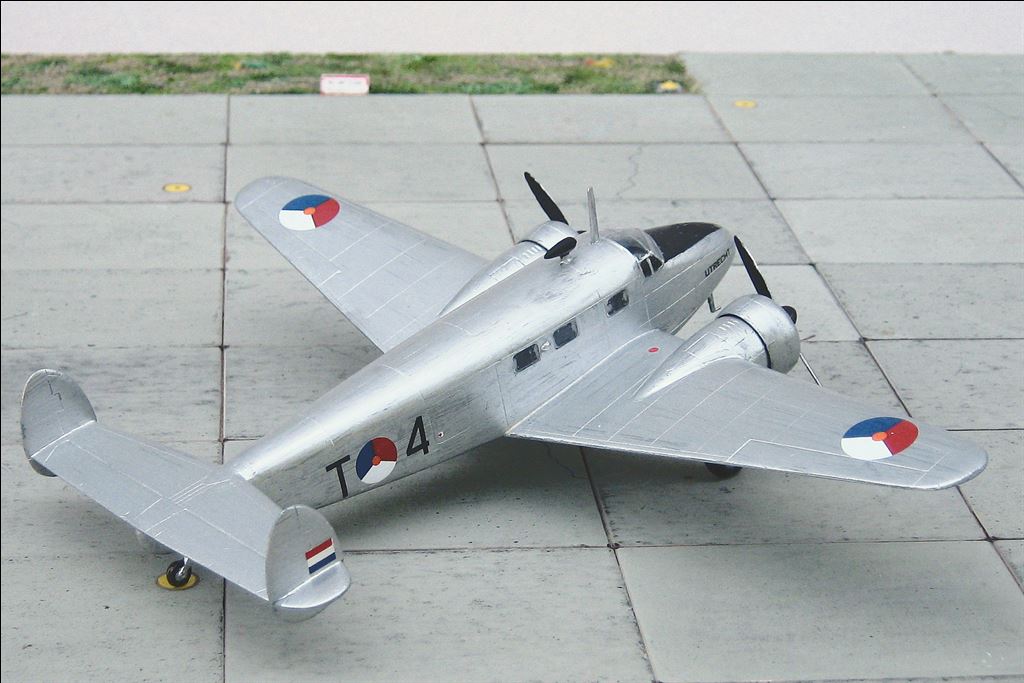
A model of a Lockheed 12A, built by Adri Kleijn.
Modeling add-on
- --
- Set --: --
Decals
- Dutch Decal
- Set 72051: Set decals for several Lockheeds 12 and 212 of LSK, RNMFS and ML-KNIL.
- Set 72055: Set decals for Hudson 320 sq, Anson 321 sq and Lockheed 12
- Dutch Profile
- Set DP-001: Set decals from Dutch Profile #1 about Lockheed 12/212.
- FlevoDecal
- Set FD72-012 ML KNIL 1939-1942:A set decals containing decal for five different Brewster Buffaloes plus Curtiss Hawk 75, Curtis CW-22, Curtiss CW-22, Lockheed Lodestar, Ryan STM; Lockheed 12, Bücker Bu131 Messerschmitt Me-108 and martin WH-1 and Wh-2.
Scale 1/48
- --
- Kit --: --
Modeling add-on
- --
- Set --: --
Decals
- --
- Set --: --
| Scheme | Colour name | FS number | BS-number | Humbrol | XtraColor | Vallejo Model Color | Vallejo Model Air | Hataka | |
|---|---|---|---|---|---|---|---|---|---|
| Lockheed L-12A NEIAF | |||||||||
| Standard #1 | Upper surfaces | Jong Blad / US Medium Green 42 | ~4092 | 149 | X114 | 70.985 | 71.124 | ~056 | |
| Undersides | Aluminium Dope | ~7178 | 191 | X216 | 70.864 | 71.062 | |||
| Lockheed 212 NEIAF | |||||||||
| Standard #1 | Overall | Bare metal | |||||||
| Standard #2 | Upper surfaces | Jong Blad / US Medium Green 42 | ~4092 | 149 | X114 | 70.985 | 71.124 | ~056 | |
| Undersides | Aluminium Dope | ~7178 | 191 | X216 | 70.864 | 71.062 | |||
Check www.paint4models.com for an extensive conversion table with lots of colour and paint systems.
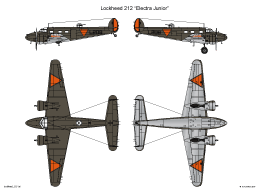
Lockheed 212 camouflage on uppersides and bare metal undersides and orange triangles as nationality markings used from early 1940 and on.
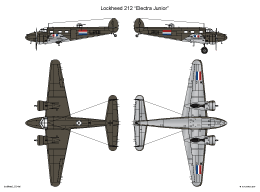
Lockheed 212 camouflage on uppersides and bare metal undersides; flags as nationality marking used from early 1942 and on.
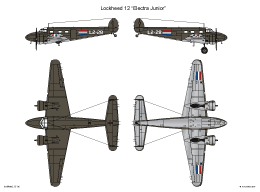
Lockheed 12: delivery scheme: camouflage on uppersides and bare metal undersides with flags as nationality markings.
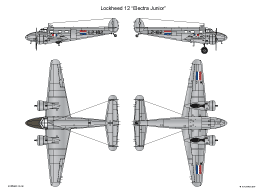
Lockheed 12, overall bare metal with flags as nationality markings and black serials, used in Australia.
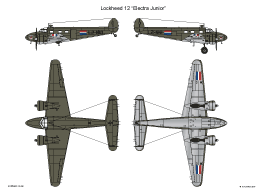
Lockheed 12 L2-100squadron hack of no 120 squadron NEI RAAF: camouflage on uppersides and bare metal undersides; flags en squadron marking on the nose.
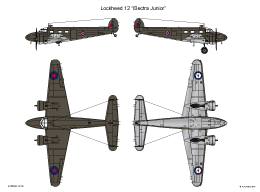
Lockheed 12 DX246: used by no 1316 DCF in England; camouflage on uppersides and bare metal undersides with RAF serials and markings.
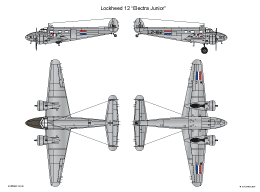
Lockheed 12 T303 of Lucht Commando Java (air command Java) of NEIAF 1947: overall bare metal with flags as nationality markings.
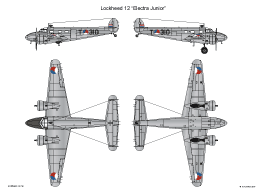
Lockheed 12, T-310: overall bare metal with flags as nationality markings and black serials as used by Advanced Flying School NEIAF.
Literature.
| Van Brik tot Starfighter | H. Hooftman | 1965 | La Rivière en Voorhoeve - Zwolle | |
| Nederlandse Militaire Luchtvaart in Beeld. deel 2 | Hugo Hooftman | Pag. 53 - 57 | 1978 | Uitgever: Europese Bibliotheek, Zaltbommel |
| Militaire Luchtvaart in Nederlandsch-Indië in beeld. Deel 1 | Hugo Hooftman | Pag. 143 - 149 | 1978 | Uitgever: Europese Bibliotheek, Zaltbommel |
| Dutch Military Aviation 1945-1978 | Paul A. Jackson | Pag. 76; 89; 125 | 1978 | Uitgever: Midland Countries Publications, Leicester |
| Militaire Luchtvaart in Nederlandsch-Indië in beeld Deel 2 | Hugo Hooftman | Pag. 88 - 94 | 1981 | Uitgever: Europese Bibliotheek, Zaltbommel |
| The Royal Netherlands Military Flying School 1942-1944 Bijdrage tot de Geschiedenis van het Zeewezen deel 16 | O.G. Ward & Boer, P.C. | Pag. 63 - 66; 83 - 85; 246 - 249 | 1982 | Uitgever: Afdeling Maritieme Historie van Min.v.Def., 's Gravenhage |
| AVIA: 41e jaargang nummer 3: Foto van Lockheed L-12-26 L2-38 (met vlag) | Pag. 118 - | 1982 | Uitgevers Wyt, Rotterdam | |
| Squadrons van de Koninklijke Luchtmacht | Willem Helfferich | Pag. 124 | 1983 | Uitgever: Unieboek b.v., Houten |
| 40 Jaar luchtvaart in Indië | Gerard Casius & Thijs Postma | Pag. 52 | 1986 | Uitgeverij De Alk, Alkmaar |
| KLu Vliegtuigen: De vliegtuigen van de Koninklijke Luchtmacht vanaf 1913 | Wim Schoenmaker & Thijs Postma | Pag. 93 | 1987 | Uitgeverij De Alk, Alkmaar |
| Luchtvaartwereld; 7e jaargang nummer 11: Lockheed 12 en 212 Electra Junior. (deel 1) | Gerard Casius | Pag. 325 - 330 | 1990 | Uitgeverij Ten Brink, Meppel |
| Luchtvaartwereld; 7e jaargang nummer 12: Lockheed 12 en 212 Electra Junior. (deel 2) | Gerard Casius | Pag. 352 - 357 | 1990 | Uitgeverij Ten Brink, Meppel |
| Luchtvaartwereld; 7e jaargang nummer 9: Lockheed 10 Electra | Harm J. Hazewinkel | Pag. 258 - 262 | 1990 | Uitgeverij Ten Brink, Meppel |
| Squadrons van de Koninklijke Luchtmacht (derde herzien druk) | Willem Helfferich | Pag. 22 - | 1994 | Uitgevers Wyt, Rotterdam |
| Nederlandse Militaire Luchtvaart 13 Lockheed 12/212 | Gerard Casius & Nico Geldhof | Pag. | 1995 | Uitgever: St. Vrienden v.h. Mil. Luchtv. Museum, Soesterberg |
| Camouflage en Kentekens | J.Greuter e.a. | 1997 | Bonneville – Bergen (NH | |
| Modelbouw in Plastic jaargang 27, nummer 3: Lockheed L-12a Baby Electra | Erwin Stam | Pag. 38 | 1998 | Uitgever: I.P.M.S. Nederland, Nederland |
| Lockheed L-12/212 | Gerard Casius | Pag. | 2003 | Uitgever: Dutch Profile, Zwammerdam |


